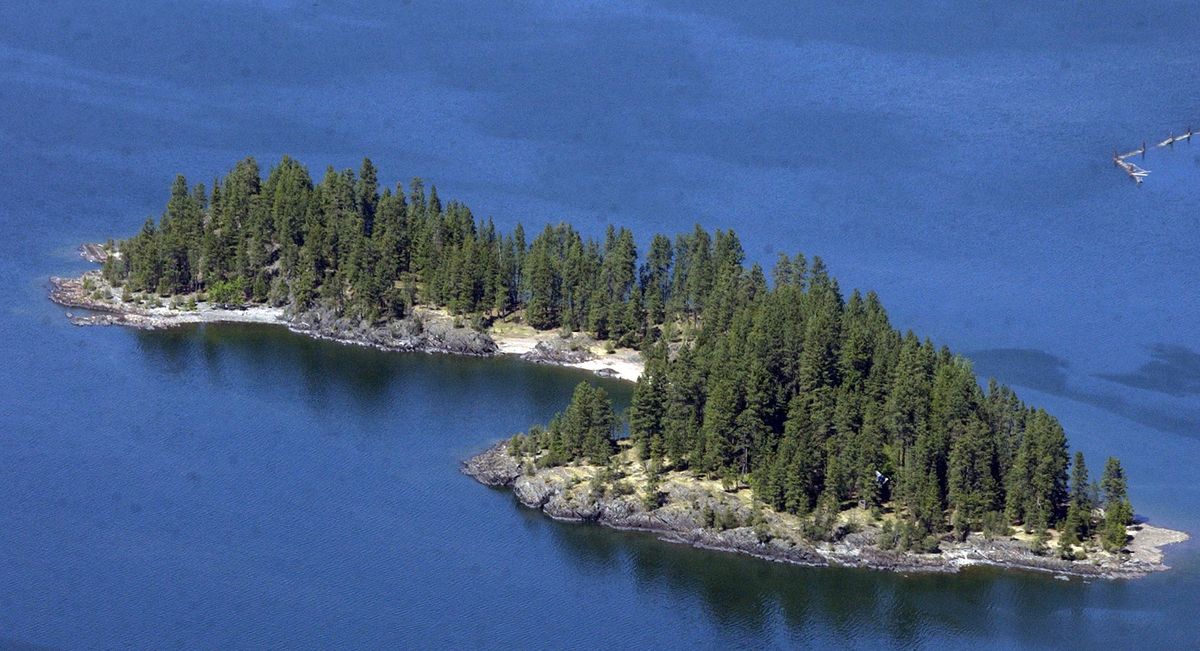Want a private island on Lake Pend Oreille? You’ll need $7 million

With its sandy cove, towering pines, views of the Green Monarchs and 13 acres of total solitude, separated from everyone by the pristine waters of Lake Pend Oreille, Memaloose Island has everything anyone looking for luxurious seclusion could ask for, except a house.
The island’s only cabin, built in the 1920s, was knocked down a few years ago, according to Brent Stevens.
Stevens co-owns Sandpoint real estate firm Century21 RiverStone with Eric Skinner, and they listed the island for sale this week at a price of $7 million.
Stevens noted that the utilities are in place for a new home to be constructed.
Or, if you have another $13 million laying around, Stevens has another solution: you can buy the island along with a six-bedroom, nine-bathroom built on the site of the Kullyspell House, which was the first fur trading post in the Northwest and reputedly the first structure built by non-Indigenous people in what is now Idaho.
That modest structure was erected in 1809, near what is now the town of Hope, and was abandoned soon after.
The 13,000-square-foot home that stands there now, however, includes a number of opulent amenities. It has a “massive underground environmentally controlled passage” to a 2,773-square-foot carriage house located on the 7 acres of waterfront property, according to the listing. It also has an elevator, according to the Bonner County Assessors Office.
Memaloose Island, on the other hand, has remained relatively undeveloped since settlers arrived in the area.
But the island has a long history that precedes the presence of European explorers, fur traders and settlers.
The Bonner County History Museum’s collection includes dozens of photos taken in the 1970s and ‘80s of petroglyphs found on the island, and it has long been suggested that the island was home to an Indian burial ground.
Previous reporting in The Spokesman-Review stated that Indigenous burial sites were identified in a state archaeological survey of the island done in the mid-20th century. The same 2005 article said that, because state law prohibits the desecration of graves or removal of funeral artifacts, any new construction on the island would require a professional survey to ensure that nothing is disturbed.
Efforts to reach the current state archeologist were not immediately successful.
Afton Servas, public relations coordinator for Kalispel Tribe of Indians, said the island “holds significance” for the tribe, both as a burial site and as the home to cultural artifacts like the petroglyphs located at “three or four sites” and documented in the museum’s collection.
She noted that “memaloose” means “grave” or “cemetery” in Chinook jargon, a hybrid language that developed as Indigenous and white people came in contact in the Pacific Northwest, and that there are multiple Memaloose Islands in the region.
Servas said tribal members maintained the burial sites on those islands until the 1930s. And she said it’s vital that they are not disturbed.
“It’s just important that those sites, regardless of who owns title to the land, continue to be protected and respected,” Servas said.
Since the early 20th century, title to the island has changed hands multiple times.
Memaloose Island entered the historical property record in 1904, when transaction indexes show Max Stenger granted the entire island to a person or entity described as “Clairus” in 1904. A year later, documents indicate J.J. Myers granted the entire island to Clairus, according to records provided by the Bonner County History Museum.
Dr. F.G. Wendle then bought the island “from a lumberjack I knew” for $5,000 in the 1920s, according to a recollection published in the Bonner County Daily Bee in 2008. The family built multiple cabins, Wendle wrote, and he and his wife raised their children there.
A California couple, Jack and Helen Knight, then bought the island in 1962 for $39,000, according to previous reporting in The Spokesman-Review.
Though they mostly used it during the summer, their son, John Knight, spent seven years living alone year-round in the island’s cabin.
After his parents’ death, John Knight and his siblings briefly listed it for sale in 2003, then put it on the block again two years later for $16 million.
That proved too pricey.
When the island finally sold in 2014, Erie Properties LLC paid $4.8 million, according to the county assessor’s office, which cited a story in the Bonner County Daily Bee that included the figure. (Property sale prices are not public in Idaho.)
Erie Properties purchased the Kullyspell House property the same year and built the main house and “gate house” in 2018.
Erie Properties, which has a mailing address in Durham, North Carolina, currently owns both properties. But Stevens, the realtor, declined to comment about who was behind the sale, citing a nondisclosure agreement.
One day after the property went up for sale, Stevens said interest in the island and Kullyspell property has been strong.
“We’ve had phone calls,” he said. “I know there’s certainly people that have a particular level of interest, and we’re just kind of vetting that out as we speak.”
And Stevens said he and Skinner “hope to get it sold fairly quickly.”
“It’s really pretty special when you’re out there,” Stevens said.